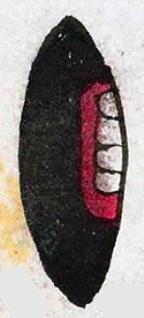itztli (Mdz42r)
This element for an obsidian blade (itztli) has been carved from the place name Itztocan (see below). It shows a vertical marquise-shaped (pointed oval), double-edged, flaked obsidian blade--much like a flint knife (tecpatl), possibly of the type used in sacrificial offerings, warfare, or possibly in hunting. It is largely black, typical of the dark and hard (but semi-transparent) mineral used for such implements. Lances and arrows also had points such as these, although smaller than a blade such as this one. Along the right side of the blade we see a vertical row of four white teeth surrounded by red gums.
Stephanie Wood
The teeth imbedded in this blade make it somewhat reminiscent of the tecpatl (flint knife), which can have eyes and fangs, such as we see in the Codex Magliabechiano and the Codex Borbonicus. We learn from sources quoted in the Online Nahuatl Dictionary that these obsidian blades often had "faces" on them, what Guy Stresser-Péan (1995, 27) calls the "demon face " (see our Bibliography). Such faces typically have two horizontal rows of teeth and a white stone eye with a black pupil. Some had handles that were also anthropomorphic, kneeling figures pushing on the blade. See, for example, the "personified flint knife" photographed in a museum and published on Mexicolore. Sometimes the teeth were more fang-like, as seen in this pre-Columbian stone carving (on the right), reminiscent of Tlaloc's fangs, perhaps.
The name Itztli was associated with a divinity or deity connected to sacrificial offerings. Another common name for obsidian or flint blades or knives was tecpatl, which could also be personified with eyes and teeth. Additionally, tecpatl was a calendrical name, and we have many examples of it in this collection.
Finally, one will see a number of black, curved obsidian blades—also associated with the term itztli—in the "see also" field of this record. Curved prismatic blades were chipped from polyhedral cores, as described in Karl Taube's research published in Ancient Mesoamerica 2:1(1991). But blades could also be cut into shapes with a curve. The Maya were better known for extremely curvy blades. These are called "eccentric flint," as published in Wikipedia.
Stephanie Wood
c. 1541, or by 1553 at the latest
Stephanie Wood
Joseph Scott and Crystal Boulton-Scott made the SVG.
knives, blades, obsidian points, flint, flints

itz(tli), obsidian blade, https://nahuatl.wired-humanities.org/content/itztli
tecpa(tl), flint or obsidian blade or knife, https://nahuatl.wired-humanities.org/content/tecpatl
obsidian, or an obsidian point or blade
la obsidiana, o la punta obsidiana
Stephanie Wood
Codex Mendoza folio 42 recto, https://digital.bodleian.ox.ac.uk/objects/2fea788e-2aa2-4f08-b6d9-648c00..., image 94 of 188.
The Bodleian Libraries, University of Oxford, hold the original manuscript, the MS. Arch. Selden. A. 1. This image is published here under the UK Creative Commons, “Attribution-NonCommercial-ShareAlike 3.0 License” (CC-BY-NC-SA 3.0).







